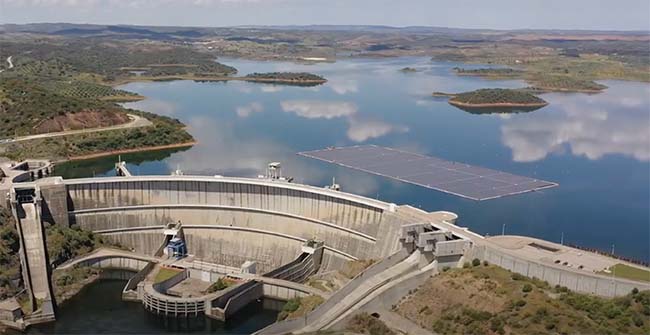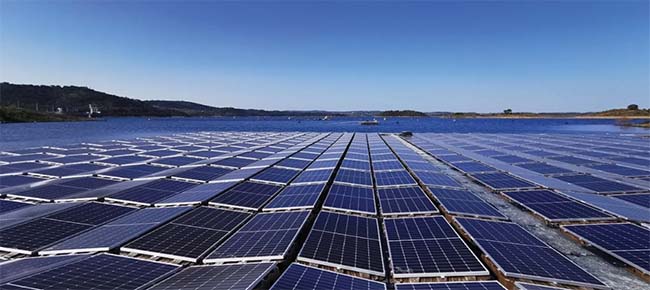Floating Solar Project Supports Portugal’s Decarbonization Strategy
Credit to Author: Darrell Proctor| Date: Fri, 01 Jul 2022 04:09:00 +0000

The largest floating solar farm in Europe, located on the reservoir for a hydroelectric dam in Portugal, is expected to begin producing power this month. The July startup of the Alqueva installation (Figure 1), on Western Europe’s largest artificial lake, is part of EDP’s plan to make its power generation net zero by 2030.
 |
1. The Alqueva Dam in Portugal is on the Guadiana River, one of the longest rivers in the Iberian Peninsula. The dam was completed in 2002. The 518-MW power station at the site was commissioned in two phases, in 2004 and 2013, respectively. Alqueva is the largest dam and artificial lake in Western Europe. The solar array is expected to enter commercial operation this month. Courtesy: EDP |
EDP, which has 25.6 GW of installed power generation capacity in its portfolio—of which 78% is renewables—already has plans to put a second, 70-MW floating solar array on the lake at the Alqueva Dam. The dam is on the Guadiana River, among the longest rivers in the Iberian Peninsula, in Alentejo, in southern Portugal near the border with Spain. EDP said the first of its two floating solar farms will generate 7 GWh annually from 12,000 solar panels. The array will pair with a 1-MW/2-MWh battery energy storage system. The installation will connect to the power grid using existing infrastructure from the hydropower plant, and is expected to provide about one-third of the electricity needed by the nearby towns of Moura and Portel.
 |
2. The floating solar array at the Alqueva Dam includes floaters that mix cork with recycled polymers, part of a manufacturing process to achieve a neutral carbon footprint. The innovation was developed by EDP in partnership with Corticeira Amorim, a Portuguese company, and Isigenere, based in Spain. Courtesy: EDP |
The Alqueva project (Figure 2) is part of Portugal’s effort to decarbonize its power generation sector. The country shut down its last coal-fired power plant in November, closing the 628-MW Pego station located northeast of Lisbon. Portugal still has four natural gas–fired plants in operation, according to government data. Much of the country’s power comes from more than a dozen hydroelectric installations, including the Alto Rabagão Dam, where in 2017 EDP installed an 840-panel pilot floating solar farm. That was the first project in Europe that tested the pairing of hydro and solar power.
“Portugal is in a great position to decarbonize with strong hydro resources on its rivers, good wind conditions on the Atlantic coast, and some of Europe’s best solar locations in the south of the country,” said Dr. Amir José Daou Pulido, market development manager at Fluence, a global energy storage and technology services provider.
Pulido told POWER that Portugal’s reliance on renewable resources likely means the country also will need to add energy storage. “Ensuring a stable power system with high levels of volatile renewables may become increasingly challenging,” Pulido said. “By integrating energy storage into its power system, Portugal will be able to shift energy from the time of generation to when it is needed. Integrating energy storage will also reduce the reliance on fossil fuels in flexibility and ancillary services markets. The technology can also play a vital role in enabling the power system to integrate ever higher shares of renewables by increasing the utilization of transmission lines, reducing congestion on the grid, and providing advanced ancillary services such as virtual inertia via grid-forming inverters.”
Portugal historically has relied on Russia for about 10% of its natural gas, but the country has been among the most vocal in calling for Europe to cut off Russian supplies after Russia’s invasion of Ukraine. Portuguese officials have said their country could import more liquefied natural gas (LNG), and increase its LNG export capacity to provide more natural gas to other European nations.
Officials also have said they want to increase the amount of renewable energy resources in Portugal and have said the Alqueva project is among many designed with that in mind. BNZ, an independent power producer that develops, builds, and operates solar projects, recently announced construction of a 49-MW solar plant in Portugal. BNZ officials said the plant will support a social project—Cuidar Maior, or Greater City—in the municipality of Vila Nova de Famalicão, in Portugal’s Norte region. Luis Selva, managing director of BNZ, said, “The company’s main objective is the production of 100% clean energy to help achieve a low-carbon future, and Portugal is a priority market for BNZ with strong growth potential in the generation of renewable technologies such as solar PV.”
Ana Paula Marques, an EDP executive board member, said accelerating Portugal’s move to more renewable energy is even more important in light of the war in Ukraine. Marques said the Alqueva project was part of EDP’s strategy “to go 100% green by 2030.”
“Portugal is already one of Europe’s clean energy leaders with 60% of its electricity coming from renewables,” said Pulido. He told POWER that the center-left Socialist Party government, elected in January of this year, “in early April moved the target of reaching 80% clean energy in electricity production forward to 2026, four years earlier than previously planned. The government sees renewables as a way to guarantee Portugal won’t be dependent on energy imports [often from fossil fuel sources], and to ensure stable and affordable electricity prices for the citizens.” Pulido said João Galamba, the country’s energy secretary, “recently announced the intention to simplify the development process for PV plants, with projects under 50 MW not requiring environmental impact assessments. This is to support faster deployment of new solar projects.”
Pulido told POWER that energy storage will support many of the country’s new solar projects. “At the end of 2021, Madeira’s energy provider, Empresa de Electricidade da Madeira (EEM), awarded Fluence, in partnership with Siemens Smart Infrastructure, a contract to install a 15-MW/15-MWh battery storage plant, which will be integrated into an islanded microgrid concept,” Pulido said. That facility, located next to Vitória Thermal Power Plant in Madeira—an autonomous region in Portugal—“will enable EEM to optimize its renewable energy integration, significantly contributing to increasing the share of renewable power to around 50% in its energy mix,” Pulido said.
“As a result, the island can reduce its fuel consumption over the next two to three years, while gaining greater energy independence without affecting energy quality or grid stability. Integrated in a microgrid concept, the battery energy storage system will also improve the island’s sustainability by reducing its carbon footprint and integrating more diversified power generation sources. At the same time, it will allow EEM to maintain high standards of reliability and availability of power distribution. One of its unique features is the ability to black-start a part of the 60-kV network and restore grid services in the event of an outage,” the Fluence executive added.
Solar-plus-storage projects are just one facet of Portugal’s renewable energy strategy. Energy Secretary Galamba last month said the auction to award leases for offshore wind projects, which the government has planned for 2023, “will happen as soon as possible and will be large,” with a capacity minimum between 6 GW and 8 GW, according to reports.
Jornal de Negócios, a Portuguese business publication, reported that Galamba said there will be an auction “more complex than the others, which is not launched in just three months, because it involves industrialization of ports.” Galamba said government officials want to start work on offshore wind “as soon as possible.”
—Darrell Proctor is a senior associate editor for POWER (@POWERmagazine).
The post Floating Solar Project Supports Portugal’s Decarbonization Strategy appeared first on POWER Magazine.